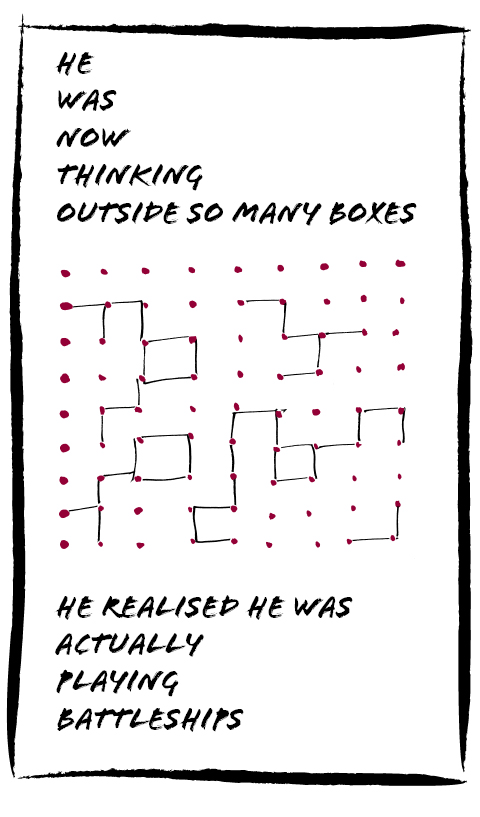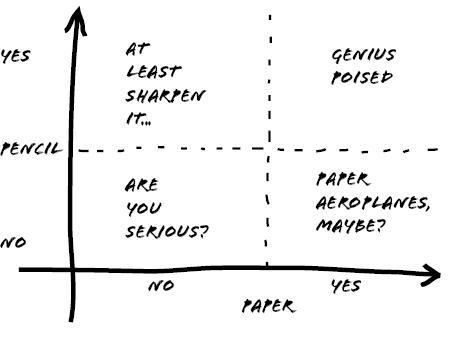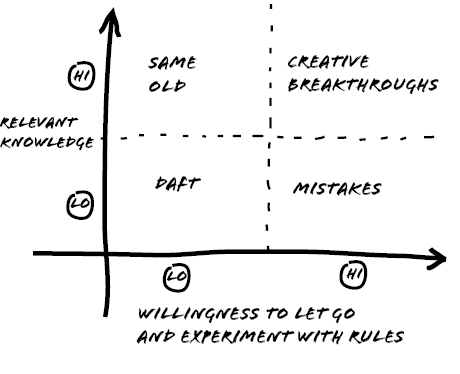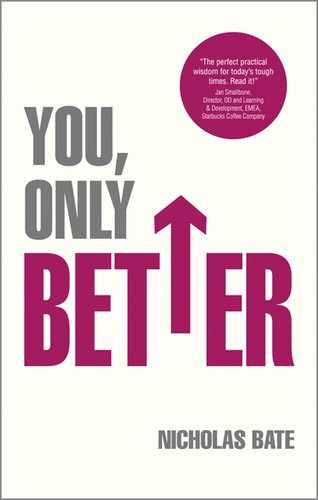Section 6
How to Be Brilliantly Creative
If you are reading this book in chapter sequence you'll be noticing a steady, building, cumulative sequence of ideas and skills. To support your career goals you need energy. You tend to have more energy when you have clarity of your compass. Of course you can only make your compass happen if you are able to focus, think things through and turn thoughts into decisions and actions. And so on. On your quest to be the best version of yourself, where to from here, though? Where to from here? How about if you make a leap, a radical change and boldly think, ‘wouldn't it be nice if I could solve any problem I have or might ever have, be it career or financial or parenting or …’
That's what we are going to do now … Really? Yes, really. Read on …
In the last chapter where we were reviewing thinking, decisions and actions, we particularly isolated proactive thinking (or what do I need to anticipate?) and critical thinking (or what do I need to do better?) and lateral thinking (or what do I need to do differently?). And you will remember that we promised to come back to this latter topic because it is so crucial in You, Only Better.
Lateral thinking is the basis of creativity. But what is creativity, or, perhaps more helpfully, what is creativity for us? Creativity for us is identifying a fresh useful solution that we hadn't considered or even thought possible before: thus as in our earlier example, instead of thinking whether you should change your current job OR leave and concentrate on your art work maybe you could think about reducing your main job to four days a week AND do your art on the fifth day.
Life is tricky. Life is changing quickly. Who knows what the job market will be like in five years' time? Who knows how your two children will turn out in their teens? Is it possible for you to make enough money to retire much earlier? The answers to such questions, the best most resourceful answers to such questions, come from being creative.
Creativity is crucial. Who doesn't constantly need fresh solutions to bringing up teenagers, solving money dilemmas, resolving challenges with neighbours and deciding quickly which dress to wear to your son's graduation? The logical, linear approach of proactive and critical thinking sometimes reaches an impasse and that's when we need the power of creativity, of fresh thinking, of lateral thinking.
But – and it's a big but – although many people do believe that if they persevere they could become better at proactive thinking or juggling or making pancakes, so many are sure, absolutely sure, that they are simply ‘not creative’.

The goal of this chapter is therefore simple:
To work, then.
7 Principles of Creativity
Read it and think of it as a mantra or ‘a simple set of instructions capable of causing transformation’. We'll clarify it all in a moment.
Let's clarify the above steps …


Let's see these principles in action.

‘I'm always struggling. I know we do a good job. I know we are great value. I know people need window cleaners. But I can't connect us to where the business is.’
Principle 6: I find time to be creative. Stop running around, start thinking. Start thinking reflectively. Look for patterns in your business. OK, the card drops don't work. Or maybe they don't work enough but they do work in some areas. Slow down, examine your successes and capitalise on those.
‘She and I are always arguing. She sees me – her mother – as out of date and controlling and trying to stop all the fun in her life. I realise that a lot of the current problems have come about because in the past I have felt guilty about not spending enough time with her and have been letting her get away with rudeness and breaking house rules.’
Principle 4: I seek no approval. To get the creative breakthrough you seek sometimes you need to defer immediate approval. You need to have a conversation with somebody which is tricky. Or you need to close down a part of a business which is not profitable for the long-term good of the rest of the business. As you think about how you can re-build this relationship, stop seeking approval. Be respectful, listen and ask that the same is done of you. Remain loving.
‘My plots are not good enough. I know that. Some professional advice for which I paid told me that and the evening class I attend tells me that.’
Principle 2: I am searching for my voice. It's good general advice that to be a writer you must be a reader. The only trouble is there comes a time when you need to let go of all of that reading and start to write for yourself, not try and copy the stories of others. Stop reading for a while and start writing a lot. Truly, a lot. Your voice will appear. And when your voice appears, your ideas will appear: the plots will no longer seem like poor photocopies but fresher, imaginative and most importantly unique.
‘My life is clutter. Physical clutter: there is hardly a surface in my flat which isn't covered in paper, books, makeup, receipts and stuff. My diary is full of things I didn't do. And my mind is spinning with worries and concerns.’
Principle 1: I am creative. You can crack this. You can sort this. Maybe you need to take a different approach and resolve your finances so that you could afford a couple of hours help from professional de-clutterers. Maybe you need to say to yourself ‘I will do 15 minutes per day – just 15 minutes a day – until it is sorted even if it takes me three months’. Maybe you just need to create one clear surface to prove to yourself that you can break the patterns. The more you talk about the chaos, the more it becomes permanent and real. The key is to realise that you are creative and there is a way around this problem.
‘I have tried to give up smoking every January for the last six years. Every New Year's Day is hell. I drink coffee until it is coming out of my ears to try and compensate. Patches everywhere. Grumpiness for everybody. I normally last two weeks.’
Principle 3: I experiment. You mentioned it yourself, you've essentially done the same thing for six years running. You probably expect it to fail. Maybe you almost feel ‘released’ when it fails. Try something different – experiment. How about if you don't try and give up smoking but you do get super healthy? Walking a significant distance every day, eating loads of fresh fruit and vegetables, going to a yoga class. And perhaps your new super healthy you will simply not want so many cigarettes to get through the day. Worth a try.
‘I have been talking for so long to so many people about getting a new job but I never do anything. Work always returns to being “OK” and I simple don't have the energy for the interviews, the endless chasing of recruitment consultants.’
Principle 7: Not tomorrow, today. You've been talking about it for over 18 months. Now is the time to start doing something about it. Make one phone call. Book one appointment. Get out there. Get some momentum. Above all, stop believing your own ‘story’ that you ‘never do anything’.
Tasks
Consider the following simple tasks as ways of boosting your creativity on a day-to-day basis.

Arthur
Arthur had a dilemma. He loved coffee and wanted to start his very own coffee shop. Now he was a realist: he knew that this enjoyment of sitting in coffee shops and drinking perfectly made lattes was a little different to getting in at 6 am to lay out the pastries for a prompt 6.30 am opening to greet the commuters. But he reckoned he knew what he was letting himself in for. Which brought him to his second challenge (his first being was he doing the right thing? Yes!): he had no money. And just the equipment was a small fortune, even second hand. And then he'd need staff and training. And maybe he needed a partner to help him especially with the finances. And suddenly instead of that feeling of excitement in his heart and gut he just had anxiety. Ugh!

This was crazy: he knew it was what he wanted to do and he was knowledgeable about coffees and equipment. But. But he was going solve this. He pinned up the creativity mantra:
Next to his shaving mirror and every morning in his favoured café he worked at it. He wrote, he thought, he captured lists, he drew pictures, he struggled. The breakthrough came on day three: change the scale. Maybe he was thinking too small: could he get some venture capital? No, no, no! Another ugh: that was the last thing he wanted. Maybe he was thinking too big! How about one of those mobile espresso machines? And that meant he didn't need to give up his current job yet. He could do it weekends or maybe evenings. There was a lot to find out about. But how could he make it different? How could he brand it? More on the actual coffee bean. He had tried coffee from those mobile ones and they didn't really play much on the coffee, it was more about convenience. Maybe he could couple convenience with brilliant coffee? And they rarely had food? Just a few muffins in cellophane? How could he solve that? And maybe gluten free for the commuters? Alright: now the ideas were flowing.
A Few Questions If I May?
1. But surely some people just are more creative?
Perhaps there is a gene or genes which make it a more natural approach for some people. But you are not wholly defined by your genes and thus your creativity is only defined by the amount of work you are willing to put into the skill. Keep going back to the seven-step mantra.
2. Can any problem be solved through creativity?
It's surprising how something seemingly insurmountable from a logical or standard viewpoint can be resolved when a lateral path is taken. So, perhaps yes: if you can be creative enough any problem can be solved.
3. I've heard about techniques such as Edward de Bono's ‘Six Thinking Hats’ etc. Why are none of these approaches mentioned?
You are of course right that over the years numerous techniques have been expounded from ‘if the problem were a body, what would the head be asking?’ to ‘make more use of the red hat’. And such techniques can have considerable value. However sometimes they simply distract from and distort your own creativity which ultimately must come from practice, self-belief and learning from feedback. So yes by all means explore books of techniques, and certainly Edward de Bono is an excellent place to start, but perhaps do not become so seduced by the tools which were designed by one person. Creativity is much more subtle than many transferable skills.
The strategy:
The deliberate practice:

